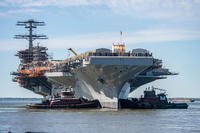The Navy has deployed underwater drones beneath the ice in the Arctic Ocean to assess how quickly the ice is melting and understand how soon the U.S. and Russia will be competing for strategic waterways in the region.
The drones are measuring the temperature and salt content to help scientists develop more accurate computer models with which to predict the anticipated future pace of melting ice, Martin Jeffries, science advisor to the Office of Naval Research, or ONR, told Military.com.
The Navy's unveiled its Arctic Road Map that explains how increasing water temperatures and decreasing ice layers mean the service will need to increase the number of ships in the region over the next 20 years, Jeffries told Military.com.
Russian President Vladimir Putin's recent aggressive stance in Ukraine has added to the urgency of this research as the Russian navy also has plans to increase their presence in the region. More Arctic Ocean waterways mean quicker and more prevalent routes for Russian ships to North America.
The Navy's Arctic Road Map addresses these threats and explains how the U.S. will require more ships in the region as the ice melts away. Predicting how quickly it will melt helps Navy leaders plan how many ships that will entail, Jeffries said.
"What we've been seeing in recent years is a much greater retreat of the sea ice cover in the summer time such that in the last eight years, we've seen the eight lowest minimum ice extent values in the artic in the satellite record going back to 1979," he said.
Less ice in the Arctic means more open water, waterways and shipping routes in the region. More open water naturally leads to increased maritime transportation and greater competition for natural resources such as oil and gas mining.
As a result, Navy scientists are using unmanned underwater autonomous robots, or drones, to examine what's called the marginal ice zone – the portion of frozen ocean's packed ice that meets open water, Jeffries explained.
"This is a very dynamic region. Our goal is to better understand what is happening in that marginalized zone in the summertime so that we can understand the retreats of ice we have seen in recent years," he said.
Navy scientists have had success in the Arctic using an underwater drone called the Seaglider, a 110-pound, 2.8-meter autonomous underwater robot able to lower acoustic sensors to depths of 1,000 meters. The Seaglider, originally developed by the ONR for open ocean data collection, can be used to gather information beneath the surface of the ice, Jeffries explained.
"We can deploy robotic technologies for sustained autonomous observing over many months - to observe the ocean, the ice and the atmosphere. Doing this with high navigation accuracy makes the scientific value of the data much greater," he said. "By the end of the summer in 2014, the science team had deployed over 100 robotic platforms in the ice and the ocean."
The Seagliders were programmed to receive acoustic signals or "pings" from underwater sources suspended on cables beneath buoys frozen into the ice at fixed locations, providing precise latitude and longitude information for the drones, Jeffries explained.
"An acoustic signal was sent to help us determine where in the water column below the ice the Seaglider was located so that we know accurately where each temperature and salinity measurement is. We learned temperature and salinity content in the water column from the surface down to depths of 1,000 meters," he said.
Having less ice in the summer means arctic waters have greater exposure to wind and sunlight, factors which can further compound the quickening pace of melting ice, Jeffries explained. Measuring the temperature of the water beneath the ice helps scientist understand how much greater exposure to wind and sunlight is mixing up the water column and potentially raising the water temperature.
Jeffries explained the scientific basis for the phenomenon by pointing to what's called the ice "albedo feedback mechanism," a term used to describe the reflectivity of the surface ice. Surface ice has a much higher "albedo," allowing it to reflect sunlight and solar radiation back into the atmosphere.
"Water is much darker and has a low ‘albedo' – it absorbs a lot more solar radiation which heats up the water," Jeffries explained. "As you heat up the water, that in turn leads to the melting of more ice so you creates this self-perpetuating cycle. As you melt more ice, you create more open water which warms up and then melts more ice."
Knowing the precise temperatures of water beneath the surface of the ice and water can provide scientists with valuable information about the extent to which wind is mixing up an otherwise highly stratified water column, moving up warmer water from deeper beneath the surface.
"The Arctic Ocean is a highly stratified ocean. It is a highly layered ocean and those layers can be measured by looking at the salinity and temperature of the water," he said.
Warmer water currents from both the Pacific Ocean and Atlantic Ocean currently flow into the Arctic region; warm waters from the Pacific are roughly 50 meters below the surface, whereas warmer waters from the Atlantic flow as deep as 200 to 250 meters below the surface, Jeffries said.
Wind-mixing could break down this water stratification and bring heat from deeper into the ocean up closer to the surface, creating warmer water which leads to more ice melting, Jeffries said.
"The wind creates more turbulence in the water column. This can mix up the water column and reduce the stability – allowing heat warmer water from deeper down to come up to the surface," he said.
-- Kris Osborn can be reached at kris.osborn@military.com



























